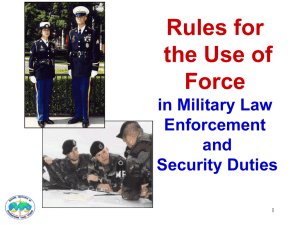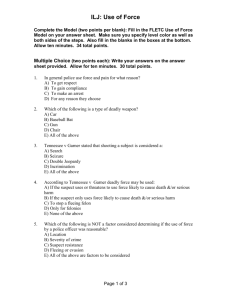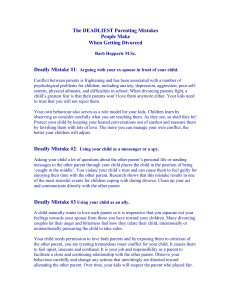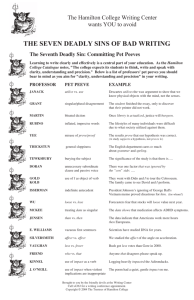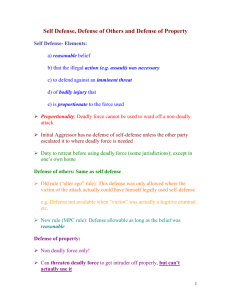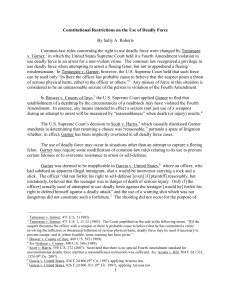use of force - Blue Cottage Taekwon-Do
advertisement
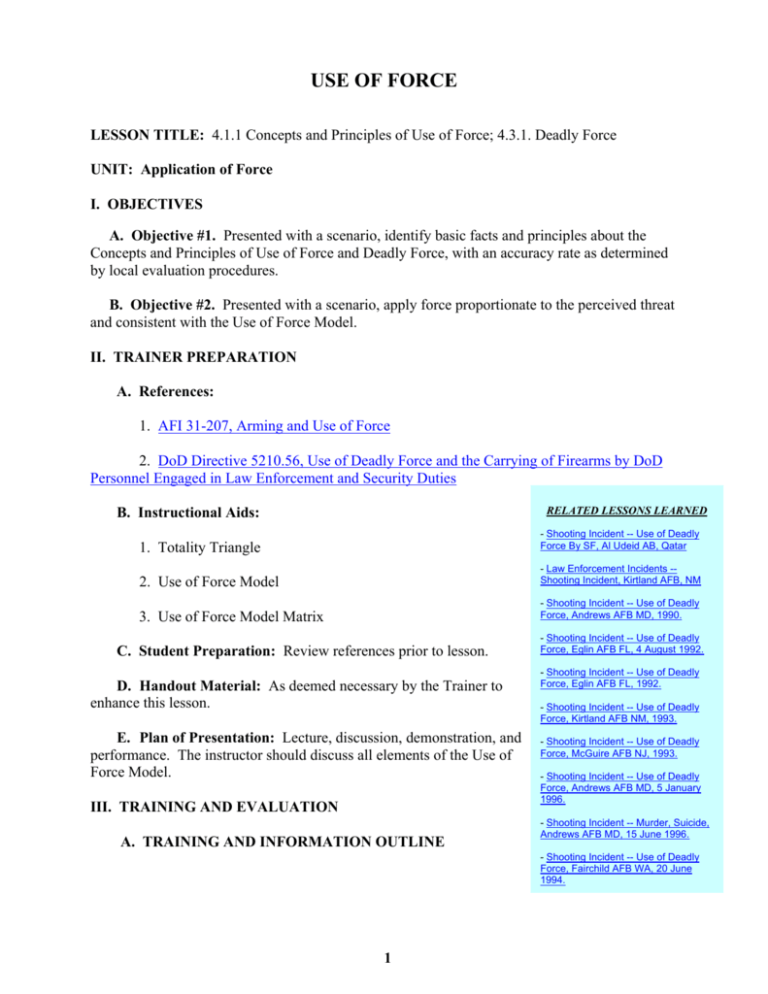
USE OF FORCE LESSON TITLE: 4.1.1 Concepts and Principles of Use of Force; 4.3.1. Deadly Force UNIT: Application of Force I. OBJECTIVES A. Objective #1. Presented with a scenario, identify basic facts and principles about the Concepts and Principles of Use of Force and Deadly Force, with an accuracy rate as determined by local evaluation procedures. B. Objective #2. Presented with a scenario, apply force proportionate to the perceived threat and consistent with the Use of Force Model. II. TRAINER PREPARATION A. References: 1. AFI 31-207, Arming and Use of Force 2. DoD Directive 5210.56, Use of Deadly Force and the Carrying of Firearms by DoD Personnel Engaged in Law Enforcement and Security Duties RELATED LESSONS LEARNED B. Instructional Aids: 1. Totality Triangle - Shooting Incident -- Use of Deadly Force By SF, Al Udeid AB, Qatar 2. Use of Force Model - Law Enforcement Incidents -Shooting Incident, Kirtland AFB, NM 3. Use of Force Model Matrix - Shooting Incident -- Use of Deadly Force, Andrews AFB MD, 1990. C. Student Preparation: Review references prior to lesson. D. Handout Material: As deemed necessary by the Trainer to enhance this lesson. E. Plan of Presentation: Lecture, discussion, demonstration, and performance. The instructor should discuss all elements of the Use of Force Model. III. TRAINING AND EVALUATION A. TRAINING AND INFORMATION OUTLINE - Shooting Incident -- Use of Deadly Force, Eglin AFB FL, 4 August 1992. - Shooting Incident -- Use of Deadly Force, Eglin AFB FL, 1992. - Shooting Incident -- Use of Deadly Force, Kirtland AFB NM, 1993. - Shooting Incident -- Use of Deadly Force, McGuire AFB NJ, 1993. - Shooting Incident -- Use of Deadly Force, Andrews AFB MD, 5 January 1996. - Shooting Incident -- Murder, Suicide, Andrews AFB MD, 15 June 1996. - Shooting Incident -- Use of Deadly Force, Fairchild AFB WA, 20 June 1994. 1 TTPG 4.1.1 Concepts and Principles of Use of Force; 4.3.1 Deadly Force ATTENTION: (Optional) As you respond to a call, you come across an individual who is verbally threatening to harm you. What level of force can you use to subdue him? MOTIVATION: (Optional) Understanding the Use of Force Model and the Air Force Use of Force Policy, will enable you to deal with situations requiring you to use force. Whether at your home base or on a deployment, the potential for using force has never been greater. OVERVIEW: This lesson will cover the Air Force Use of Force Policy, the Use of Force Model, the Use of Deadly Force, and Special Considerations for the Use of Deadly Force. 1. Use of Force Overview. The proactive management of use of force is critical to mission effectiveness. The risk of liability or bad publicity from the excessive use of force is indeed an ever-present issue in today’s society. The following information is designed to prepare Air Force personnel to more effectively apply and explain their application of force. As the information is presented, keep these two main principles in mind: a. Force: any effort or energy to detain or control. b. Force can be used when objectively reasonable. 2. USAF Use of Force Policy. Air Force personnel use only that force which is reasonably necessary. Avoid the use of force not essential to carrying out assigned responsibilities. a. Tailor the type and level of force to its necessity. You must base your use of force option on the actions of the individual(s) with whom you are in contact. b. Once a particular level of force is no longer required, you must discontinue its use despite the fact a suspect’s efforts to thwart or evade a seizure may arouse normal passions of anger, fear, or frustration. c. If you use excessive force in discharging your assigned responsibilities, you are subject to administrative or judicial action. d. Authority for such action is in the UCMJ, Article 92; or United States, local, or host-nation laws. 3. Use of Force Model. The Model is designed to assist you in the overall knowledge, understanding, and application of proper force management. The Model replaces all reference to intent, opportunity, and capability. A consolidated effort to educate and train Air Force members in Use of Force issues begins with the use of a visual aid to facilitate learning of the various levels of force and the appropriate responses. a. The UFM is a three-sided, five-tier structure. It is the basis by which discussions and questions will be addressed as to how much force is appropriate for a variety of situations with which you may be faced during training exercises and real world situations. b. The UFM describes the progression or de-escalation of force based upon the 2 TTPG 4.1.1 Concepts and Principles of Use of Force; 4.3.1 Deadly Force demonstrated level of compliance or resistance. Ideally, each encounter flows in a logical and legal sequence of cause and effect based upon reasonable perception of risk, causing you to escalate, de-escalate, or maintain a level of appropriate force to gain or maintain control of the subject. c. The elements involved in the use of force; risk perception, subject action, and “officer response” is essential for a balanced use of force. They are referred to as the “Totality Triangle”. RISK PERCEPTION SUBJECT ACTION OFFICER ACTION Figure 4.1.1.1. Totality Triangle (1) Subject Action - the action (s) perceived by the “reasonable officer” that place the subject in one or more of the Model’s compliant/non-compliant categories. (2) Risk Perception - the situations that are perceived by the “reasonable officer” within a confrontational environment which present a risk or potential risk to officer safety. Issues including the severity of the crime, degree of subject non-compliance, knowledge of the subject’s previous actions, etc., can act as a test for reasonableness and a criteria for placement in one or more of the perception categories on the UFM (3) “Officer Response” - the “balanced” response the reasonable officer could and/or would select from the UFM’s identified categories, in order to maintain or re-gain subject compliance and control. d. Each of these elements is integrated in a tri-facet, five tier, color enhanced 3 TTPG 4.1.1 Concepts and Principles of Use of Force; 4.3.1 Deadly Force structure: the Use of Force Model. The proper perception and assessment of risk is the core consideration in the decision-making process toward proper force utilization. It is the functional foundation for the two other major model categories and integral to their understanding and application. To enhance this role and its retention, color has been selected as an essential medium for the message. (6) Risk Perception Categories. Theses area situations that are perceived by the “reasonable officer” within a confrontational environment which present a risk or potential risk to the officer’s safety. Issues including the severity of the crime, degree of subject noncompliance, knowledge of the subject’s previous actions, etc., can act as a test for reasonableness and a criteria for placement in one or more of the perception categories on the UFM. (a) Professional. This is the broad foundation of the UFM represented by the blue baseline of the risk perception spectrum. Here the officer is engaged in duties with occupationally produced perception of responsibilities and risks. Figure 4.1.1.2. Use of Force Model (1) Risk Perception. (a) Professional. The officer is engaged in duties with an occupationally produced perception of responsibilities and risks. (b) Tactical. The second category on the UFM is depicted by the color green. At this level the officer perceives an increase of risk within the confrontational environment and safety strategies are deployed. (c) Threshold. The third category on the UFM utilizes the color yellow to indicate an activated degree of alertness where specific risks are identified by the officer. Many times this category represents the most critical intervening level or phase within a confrontation. If the officer assesses the subject’s actions properly he may be able to stabilize the degree of non-compliance at a resistant level before it escalates to an actual assault on the officer or others. Here, a tactical plan of action must be developed and deployed to gain compliance and control. 4 TTPG 4.1.1 Concepts and Principles of Use of Force; 4.3.1 Deadly Force This advanced degree of risk potential should motivate the officer to increase the level of receptiveness more formally away from the actor and more directly toward the actions of the subject and others present. (d) Harmful. This category on the UFM the color orange denotes an accelerated perception of danger and a more directed focus on officer/citizen safety and defense. (e) Lethal. The highest category of risk on the Model correlates to the most intense color in the light spectrum, red. This potentially lethal category of risk is the most infrequent and yet the most crucial for officer/citizen. (2) Subject Action Categories. This consists of five categories of perceived subject actions, potentially providing the additional foundational focus for an appropriate, "balanced" response of controlling force. Note that absolute definitions and/or demarcations of human conduct are in reality, difficult, if not impossible, to identify with great specificity. However, the “reasonable officer’s” perceptions of the subject’s action (s) are a necessary portion of the officer’s decision-making process toward proper force utilization. (a) Compliant. Within the normal realm of interaction, the vast majority of officer/subject encounters are positive and co-operative. The officer maintains or gains compliance to desired directives via options of tradition, time, communication skills, etc. (b) Resistant (Passive). In some confrontational contacts, the subject may offer a preliminary level of non-compliance. Here the subject’s degree of non-compliance is free of physical or mechanical enhancement, other than sheer unresponsiveness. (c) Resistant (Active). At this level, the subject's non-compliance has become more active in scope and intensity. The indifference to control has increased to a level of energy enhanced physical or mechanical defiance. (d) Assaultive (Bodily Harm). The officer's attempt to gain lawful compliance has met with active, non-compliance culminating in an actual attack upon the officer or others. Here, the scope and severity of the attack, would not support the reasonable officer’s assessment of death or serious bodily harm to occur to the officer or others. (e) Assaultive (Serious Bodily Harm/Death). This category represents the least encountered, yet most serious risk to officer safety. Here the reasonable officer could conclude that the officer or another, is subject to death or great bodily harm as a result of the subject's actions. (3) Officer Response Categories. This facet of the UFM consists of the five categories of officer initiated response, “balanced” in regard to the officer’s reasonable assessment of risk and subject action in order to maintain or regain subject compliance and control. (a) Cooperative Controls. Includes the fundamentals of professional training 5 TTPG 4.1.1 Concepts and Principles of Use of Force; 4.3.1 Deadly Force capitalizing upon the acceptance of authority by the use of a variety of controls including; communication skills, common tactics, body language, etc. (b) Contact Controls. In this first instance of non-compliance the officer must deploy tactical talents to proportionately gain control and cooperation through "hands on" techniques designed primarily to guide or direct the subject. The primary force component at this level could be transitional tactics, non-pain compliance techniques, etc., under the heading of RESISTANT (Passive) COUNTERMEASURES. (c) Compliance Techniques. Tactical procedures at this level now must address the non-compliant subject who has begun to use physical or mechanical energy to enhance non-compliance. The officer deploys “balanced” force to overcome this noncompliance, while remaining increasingly vigilant for more aggressive behavior from the subject. At this stage the force forms could include elements of pain compliance, chemical irritants, joint restraints, Taser, etc. under the heading of RESISTANT (Active) COUNTERMEASURES. (d) Defensive Tactics. At this stage in the confrontation, the non-compliant subject now directs an assaultive act toward the officer or others. The officer is justified in taking appropriate steps to immediately cease the assaultive action and to gain compliance and maintain control of the subject. Forms of force could include weapon strikes under the heading of ASSAULTIVE (Bodily Harm) COUNTERMEASURES. (e) Deadly Force. The officer is now confronted with an assaultive situation that reaches the ultimate degree of danger. Absolute and immediate tactics must be deployed to stop the lethal risk and secure conclusive compliance and control. Force options could include those leading to permanent debilitation or even death, and are identified under the heading of ASSAULTIVE (Serious Bodily Harm/Death) COUNTERMEASURES. e. Within each level of the UFM, the intensity of the color increases as we move from the Subject Action Categories, through the categories of Risk Perception, and to the Officer Response Categories. In each application, the intensity of the color is always superior at the correlated Officer Response Category. This visualization of color intensity is used to enhance the understanding and maintain the principle that the officer must maintain constant, controlled superiority over the subject's degree of non-compliance at a "balanced" level of objectively reasonable force utilization. f. The double-headed assessment/selection arrows indicate the dynamic and fluid nature of the processing of information toward proper decision-making during a confrontation. The principle incorporated into proper compliance and control is that of tactical transition, which includes escalation, stabilization, and/or de-escalation in force applications. The properly trained member will be conditioned to flow with the circumstances of the specific situation to properly control the confrontation. The center portion of each of the arrows is presented in white to indicate that each incident must be primarily based on the information currently being presented and not unduly influenced by previous contacts with the subject or the situation, either positive or negative. g. Each arrow is bordered with the survival shadow in red. This color enhancement 6 TTPG 4.1.1 Concepts and Principles of Use of Force; 4.3.1 Deadly Force is provided to indicate and maintain the constant retention of lethal risk perception, inherent in any officer/subject confrontation. 2. Progressive Application of Force. The UFM supports the widely accepted premise and practice of progressive application of force. This simply implies the process of appropriate selection of force options in response to reasonable assessment of risks presented in the confrontation; the level of compliance or degrees of non-compliance from the individual to be controlled; and proper selection of an objectively reasonable response. Each officer/citizen confrontation should flow in a logical and legal sequence of cause and effect. The member’s tactical transition must be capable of escalation or engagement, stabilization of the situation, or de-escalation or disengagement within the context of the confrontation toward the eventual goal of compliance and control. USE OF FORCE MATRIX RISK PERCEPTION SUBJECT ACTION Professional Compliant OFFICER RESPONSE Cooperative Controls Tactical Resistant (Passive) Contact Controls Threshold Threat Resistant (Active) Compliance Techniques TOOLS AVAILABLE - Mental Preparation - Spatial Positioning - Verbal Controls - Search Techniques - Apprehension Tactics - MWD Presence - Any tool from previous level - Verbal Manipulation Techniques - Handcuffing Techniques - Wrist elbow position - Hand rotation position - Any tool from previous levels - Neuromuscular Controls - Chemical Irritant Application - SF Baton (Non-striking) - Taser - MWD (Off-leash) Harmful Threat Assaultive (Bodily Harm) Defensive Tactics - Any tool from the previous levels - Escape Techniques - Assault Defenses - Weapon Retention Techniques - Impact weapons (non-lethal) Lethal Threat Assaultive (Serious Bodily Harm/Death) Deadly Force - Any tool from the previous levels - Firearm Utilization Figure 4.1.1.3. Use of Force Matrix a. Progressive Application of Force encompasses three main elements of action and assessment: tools, tactics, and timing. 7 TTPG 4.1.1 Concepts and Principles of Use of Force; 4.3.1 Deadly Force (1) Tools include the two broad forms of subject control; mental manipulation (verbal skills, body language, officer presence, etc.) and physical manipulation (weaponless controls, weapons, restraints, etc.). (2) The tactics encompass the actual application of these tools into actual strategies deemed necessary and viable in the confrontational setting. (3) Timing is demonstrated by the degree of actual force deemed necessary; based upon the “reasonable officer's” ongoing assessment of risks, the “reasonable officer's” perceived actions of the subject, and the available options of control; measured in terms of reasonableness. b. Applying force with the appropriate tool. (1) Tools available at the first level (Cooperative Controls) include: (a) Mental Preparation: Perception skills, risk assessment, and survival orientation. (b) Spatial Positioning: Stance, body language, and relative positioning. (c) Verbal Controls: Communication skills, interviewing, and behavioral assessment. (d) Individual searching techniques: Frisk techniques, opposite sex searches, position (standing, prone). (e) Apprehension Tactics: Single/Dual subject, escort controls and transport controls. (f) Military work dog presence. (2) Tools available at the second level (Contact Controls) include those in the first level and: (a) Verbal Manipulation Techniques: Targeted towards changing the behavior of an individual (basic conflict management) or of a group of individuals (basic crisis management). (b) Handcuffing Techniques: Standing and prone. (c) Wrist elbow position. (d) Hand rotation position. 8 TTPG 4.1.1 Concepts and Principles of Use of Force; 4.3.1 Deadly Force (3) Tools available at the third level (Compliance Techniques) besides those available in the first and second include: (a) Neuromuscular controls. (b) Chemical irritant application. (c) Baton used as leverage devices or in pain compliance role (non-striking). (d) Taser (e) K-9 (off-leash). (4) Tools available at the fourth level (Defensive Tactics) include those from the three levels below and: (a) Escape Techniques: For use in escape from grabs and chokes. (b) Assault defenses: To include use of head, hands, elbows, feet and knees in warding off or countering the subject assault. (c) Impact Weapons: To include the baton or riot stick as well as anything at hand for use in fending off or gaining control of the subject. Blocks, strikes, and jabs to nonlethal areas would be justified. (d) Weapon retention. (5) Tools available at Level V (Deadly Force) include those formerly outlined in Levels I-IV and Firearms. c. Three tactical issues concerning Use of Force. (1) The principle strategic focus in the enforcement environment is to continue to promote and practice the confrontation equation; which by definition is simply the officer remaining in a constant position of recognizable advantage within any confrontation, while the subject stays in a continued position of recognizable disadvantage. One vivid and viable illustration of this tactical equation is the practice of the 2 on 1 advantage ratio of officers to subject, as the rule, rather than the exception. (2) The focus toward the confrontation should be primarily placed upon the "actions" of the subject, rather than the important, but secondary attributes of the "actor" in the situation. Certainly the "who" involved is of concern (i.e. past actions, previous history of violence, the subject’s size/strength, etc.), but primary focus needs to be directed toward "what" is happening at the time - what the subject is doing. The “reasonable officer” must guard against being lulled into complacency by past knowledge of the subject, or placing himself in crisis by pre-judging a mode of force utilization based upon previous contact, not present at this point in time. 9 TTPG 4.1.1 Concepts and Principles of Use of Force; 4.3.1 Deadly Force (3) When placed into a confrontation, the “reasonable officer” must expand his perspective from the common practice of “reaction” into a more strategic confrontational conduct of an action-initiated response. (a) This response should be pro-active, drawn upon the expertise and experience with the actual subject and situations, or other similar participants and incidents. The officer should remain free of the pressure to pre-judge the actions of the subject, and gain the enhanced ability to more properly perceive the actual and/or potential actions of the subject in question. (b) Ideally, the officer should practice anticipatory behavior (stress reduction techniques, conflict voidance/resolution tactics, fear management skills, etc.) to attempt to prevent potential non-compliant confrontations. Or, if a conflict is perceived as inevitable, he should initiate procedures to provide sufficient systems (strategic planning, team tactics, etc.) to maximize the status of safety for himself, others, and the actual subject. (c) The response must be active, in that the controlling tactics the officer initiates will accomplish the re-control of the subject with a high degree of effectiveness and safety to the officer and to others. In this manner, the confrontation can be controlled as efficiently as possible, thus avoiding the selection of higher levels of force utilization with the inherent risks of greater potential injury to the officer, the subject, or others. (d) And finally, the response must be re-active, directing the officer's actions toward a mode of prevention via the tactical application of "Lesson’s Learned", or response based research. Most confrontations are not unique or remain isolated in time, their components will re-occur at other times with other subjects. If a safe, successful solution evolves, the officer should follow that course of response in the future. If the solution is not found, the officer should use the past experience as a catalyst to seek a safe, strategic, future solution. (e) This principled, status of safety, can only be maintained if the officer strategically and systematically anticipates, assesses, and acts within the effective and accepted parameters of the situation. The officer must understand that this process, and its products exist in an environment that is ever changing in definition, direction, and depth. 4. Principles and Practices in the Use of Deadly Force a. The use of deadly force must meet the ‘objective reasonableness’ standard. The fourth amendment to the US Constitution sets the limits for the use of force by personnel engaged in effecting arrests or other seizures of persons. (1) In Graham v. Connor, 490 U.S. 386 (1989), the US Supreme Court established the fourth amendment standard of “objective reasonableness” as the appropriate standard for assessing the use of force in the context of making an arrest or other seizure of a person. It explained its application in these terms: (2) “[T]he question is whether the officers’ actions are ‘objectively reasonable’ in light of the facts and circumstances confronting them..... The reasonableness of a particular use 10 TTPG 4.1.1 Concepts and Principles of Use of Force; 4.3.1 Deadly Force of force must be judged from the perspective of a reasonable officer on the scene, rather than with the 20/20 vision of hindsight. ...the ‘reasonableness’ inquiry...is an objective one....” b. Use deadly force only when facing conditions of extreme necessity, when all lesser means of force aren't feasible or have failed, and only under one or more of these circumstances as set forth in DoD Directive 5210.56. (1) Self- Defense and Defense of Others. You may use force, including deadly force, when you reasonably believe you or others to be in imminent danger of death or serious bodily harm. (2) Protection of Assets Involving National Security. You may use force, including deadly force, to protect DoD assets designated as vital to the national security. The DoD designates its assets as "vital to the national security" only when their loss, damage, or compromise would seriously jeopardize the fulfillment of a national defense mission. This normally includes protection level assets as defined in AFI 31-101, Air Force Physical Security Program. Installation commanders must identify the resources specifically designated as vital to national security, or the procedures they will use to inform armed personnel of such specifically designated property in their installation security plan. (3) Protection of Assets Not Involving National Security But Inherently Dangerous to Others. You may use force, to include deadly force, to protect DoD assets not involving the national security but inherently dangerous to others. This category includes (a) Weapons. (b) Ammunition. (c) Missiles. (d) Rockets. (e) Explosives. (f) Chemical agents. (g) Special nuclear material. (h) Installation commanders must identify the resources specifically designated as inherently dangerous to others or the procedures they will use to inform armed personnel of such specifically designated property in their installation security plan. These assets include, but are not limited to, 1 Hamlet. 2 Redeye. 3 Stinger. 11 TTPG 4.1.1 Concepts and Principles of Use of Force; 4.3.1 Deadly Force 4 Dragon. 5 Viper. 6 Other anti-armor non-nuclear ready-to-fire missiles. 7 Light automatic firearms. 8 Heavy machine guns. 9 Mortars. 10 Grenade launchers. 11 Flame throwers. 12 Handguns. 13 Rifles. 14 Shotguns. 15 Recoilless rifles. 16 Explosive. 17 Incendiary hand grenades. 18 Explosive mines. 19 High explosives such as TNT, dynamite, and C-4 plastic. 20 High explosive fuses and detonation cord. 21 Blasting caps. 22 Bulk riot control agents. 23 Associated ammunition for the above firearms. (4) Prevention of Serious Offenses Against Persons. You may use force, including deadly force, to prevent the commission of a serious offense involving violence and threatening death or serious bodily harm. (5) Arrest or Apprehension. You may use force; to include deadly force, when it reasonably appears necessary to arrest, apprehend, or prevent the escape of a person suspected of committing an offense of the nature specified paragraphs (1), (2), and (3) above and it reasonably appears that the suspect presents an immediate danger to you or to others. 12 TTPG 4.1.1 Concepts and Principles of Use of Force; 4.3.1 Deadly Force (6) Escape. You may use force, to include deadly force, when it appears reasonably necessary to prevent the escape of a prisoner who threatens serious bodily harm or death to escorting personnel or other persons. During an escape attempt, you must have probable cause to believe the prisoner is attempting to escape and that the escaping prisoner poses a threat of serious bodily harm either to yourself or others. (7) Protection of Public Health or Safety. You may use force, to include deadly force to prevent the destruction of public utilities or similar critical infrastructure vital to public health or safety, the damage of which, would create an imminent danger of death of serous bodily harm. 5. Special Considerations for the Use of Deadly Force a. Fire shots only with due regard for the safety of innocent bystanders. Do not fire shots if they are likely to endanger innocent bystanders. When possible, give an order to "HALT" before discharging a firearm to prevent death or serious bodily harm to others. b. When you are under hostile attack in protection and recovery operations involving nuclear weapons or lethal chemical agents, the presence of innocent bystanders or hostages must not deter you from stopping the attack through all means at your disposal. c. When you discharge a firearm, fire it with the intent of rendering the targeted person or persons incapable of continuing the activity or course of behavior that led you to shoot. Rendering incapable may not require death in every circumstance. Do not fire shots as a warning to suspects except as otherwise provided by overseas theater directives. d. Commanders may impose further restrictions on the use of deadly force to comply with local and host-nation laws. Such restrictions must not unduly compromise the security interests of the United States. MAJCOMs must list restrictions imposed by local or host-nation laws in their supplements to the Arming and Use of Force by Air Force Personnel instruction. SUMMARY: The Use of Force Model is a mechanism for use in understanding the dynamics of the use of force. Its implied principles must be transmitted from the classroom to the street. The Use of Force Model provides an additional degree of clarity and focus to this critical topic of contemporary law enforcement. Remember, implementation of the Use of Force Model is your responsibility. REMOTIVATION: (Optional) CLOSING: (Use closing statement to ensure students understand the training session has ended.) 13 TTPG 4.1.1 Concepts and Principles of Use of Force; 4.3.1 Deadly Force B. EVALUATION/CERTIFICATION 1. Evaluator/Certifier Preparation a. Setup: (1) Develop written and/or oral evaluations in accordance with AFI 362225, Security Forces Training and Standardization and Evaluation Programs, for evaluation of Objective #1. (2) Develop exercise scenarios requiring the use of different levels of force to adequately evaluate the member’s understanding of the application of the varying levels of force for evaluation of Objective #2. The use of a firearms training simulator or similar device is highly recommended for evaluation of this objective. b. Location: Select a classroom setting for evaluation of Objective #1. Select a location suitable for implementation of scenarios and evaluation of Objective #2. 2. Evaluation/Certification Guide a. Brief member on objectives as stated on Task Performance Checklist(s) prior to evaluation. b. Member must complete all task items listed on the Task Performance Checklist(s). Failure to accomplish any of the items will result in an “unsatisfactory” evaluation. c. Document training and evaluation results in accordance with governing directives. d. Review Training: Member will undergo review training on all task items missed. e. Re-evaluation: Member will be re-evaluated on all task items missed after undergoing review training. 3. Performance Measures. Refer to attached Task Performance Checklists 14 TTPG 4.1.1 Concepts and Principles of Use of Force; 4.3.1. Deadly Force TASK PERFORMANCE CHECKLIST NAME GRADE SECTION CAFSC DATE ASSIGNED EVALUATION DATE EVALUATION TRAINEE’S INITIALS SATISFACTORY UNSATISFACTORY 3 TASK LEVEL 5 TASK LEVEL 7 TASK LEVEL NAME AND TITLE OF EVALUATOR GRADE APPLICABLE TO SCORING INSTRUCTIONS Indicate task performance by placing an “X” in the “YES” or “NO” column. Explain all “NO” ratings in the “REMARKS” column and schedule Review Training followed by re-evaluation. Individuals must successfully complete ALL items identified by their skill level. SUBJECT Use of Force TASK ITEM A EVALUATION OBJECTIVE: Identify basic facts and/or principles about the USAF Use of Force Policy. SKILLLEVEL B NO D YES C REMARKS E DATE OF RE-EVALUATION F 1. Describes purpose of Use of Force Model. To assist in the overall knowledge, understanding, and application of proper force management. 2. Describes the (3) elements involved in Use of Force essential for a balanced use of force. Referred to as “Totality Triangle.” a. Risk Perception b. Subject Action c. Officer Action 3. Identifies and describes the (5) “Risk Perception” categories and associated color. a. b. c. d. e. Professional (Blue) Tactical (Green) Threshold (Yellow) Harmful (Orange) Lethal (Red) AF FORM 689, APR 99, (EF-V1) PREVIOUS EDITIONS ARE OBSOLETE. YES G NO H REMARKS I TTPG 4.1.1 Concepts and Principles of Use of Force; 4.3.1. Deadly Force TASK ITEM A SKILLLEVEL B YES C NO D REMARKS E DATE OF RE-EVALUATION F 4. Identifies and describes the (5) “Subject Action” categories. a. b. c. d. e. Compliant Resistant (Passive) Resistant (Active) Assaultive (Bodily Harm) Assaultive (Serious Bodily Harm/Death) 5. Identifies and describes the (5) “Officer Response” categories. a. b. c. d. e. Cooperative Controls Contact Controls Compliance Controls Defensive Tactics Deadly Force 6. Within the Progression Application of Force, identifies/describes the (3) main elements of action and assessment. a. Tools b. Tactics c. Timing AF FORM 689, APR 99, (EF-V1) Reverse PREVIOUS EDITIONS ARE OBSOLETE. YES G NO H REMARKS I TTPG 4.1.1 Concepts and Principles of Use of Force; 4.3.1. Deadly Force TASK ITEM A SKILLLEVEL B YES C NO D REMARKS E DATE OF RE-EVALUATION F 7. Identifies tools available for use at the first level of the Use of Force Model (Cooperative Controls). a. Mental Preparation b. Spatial Positioning c. Verbal Controls d. Search Techniques e. Apprehension Tactics f. MWD Presence 8. Identifies tools available for use at the second level on the Use of Force Model (Contact Controls). a. b. c. d. e. Any tool from previous level Verbal Manipulation Techniques Handcuffing Techniques Wrist-Elbow Position Hand Rotation Position 9. Identifies tools available for use at the third level on the Use of Force Model (Compliance Techniques). a. b. c. d. e. Any tool from previous levels Neuromuscular Controls Chemical Irritant Application SF Baton (Non-striking) MWD (off-leash) AF FORM 689, APR 99, (EF-V1) REVERSE PREVIOUS EDITIONS ARE OBSOLETE. YES G NO H REMARKS I TTPG 4.1.1 Concepts and Principles of Use of Force; 4.3.1. Deadly Force TASK ITEM A 10. Identifies tools available for use at the fourth level on the Use of Force Model (Defensive Tactics). a. b. c. d. e. Any tool from previous levels Escape techniques Assault Defenses Weapon Retention Techniques Impact Weapons (non-lethal) 11. Identifies tools available for use at the fifth level on the Use of Force Model (Deadly Force). a. Any tool from the previous levels b. Firearm utilization 12. Describes the “Confrontation Equation.” When the officer remains in a constant position of recognizable advantage within any confrontation, while the subject stays in a continued position of recognizable disadvantage. 13. Describes “Objective Reasonableness” standard as it relates to use of deadly force. [T]he question is whether the officers’ actions are ‘objectively reasonable’ in light of the facts and circumstances confronting them..... The reasonableness of a particular use of force must be judged from the perspective of a reasonable officer on the scene, rather than with the 20/20 vision of hindsight. ...the ‘reasonableness’ inquiry...is an objective one....” SKILLLEVEL B YES C NO D REMARKS E DATE OF RE-EVALUATION F YES G NO H REMARKS I TTPG 4.1.1 Concepts and Principles of Use of Force; 4.3.1. Deadly Force TASK ITEM A SKILLLEVEL B YES C NO D REMARKS E DATE OF RE-EVALUATION F 14. Identify “Special Considerations” for use of Deadly Force. a. Fire shots only with due regard for the safety of innocent bystanders. (1) Do not fire shots if they are likely to endanger innocent bystanders. (2) When possible, give an order to "HALT" before discharging a firearm to prevent death or serious bodily harm to others. b. When you discharge a firearm, fire it with the intent of rendering the targeted person or persons incapable of continuing the activity or course of behavior that led you to shoot. (1) Rendering incapable may not require death in every circumstance. (2) Do not fire shots as a warning to suspects except as provided by overseas theater directives. AF FORM 689, APR 99, (EF-V1) REVERSE PREVIOUS EDITIONS ARE OBSOLETE. YES G NO H REMARKS I TTPG 4.1.1 Concepts and Principles of Use of Force; 4.3.1. Deadly Force TASK PERFORMANCE CHECKLIST NAME GRADE SECTION CAFSC DATE ASSIGNED EVALUATION DATE EVALUATION TRAINEE’S INITIALS SATISFACTORY UNSATISFACTORY 3 TASK LEVEL 5 TASK LEVEL 7 TASK LEVEL NAME AND TITLE OF EVALUATOR GRADE APPLICABLE TO SCORING INSTRUCTIONS Indicate task performance by placing an “X” in the “YES” or “NO” column. Explain all “NO” ratings in the “REMARKS” column and schedule Review Training followed by re-evaluation. Individuals must successfully complete ALL items identified by their skill level. SUBJECT EVALUATION OBJECTIVE: Presented with a scenario, apply the use of force proportionate to the perceived threat consistent with the Use of Force Model. Use of Force TASK ITEM A 1. Compliant Subject (uses one or more of the following tools) a. b. c. d. e. f. Mental Preparation Spatial Positioning Verbal Controls Search Techniques Apprehension Tactics MWD Presence 2. Resistant (Passive) (uses one or more of the following tools) a. b. c. d. e. Any tool from previous level Verbal Manipulation Techniques Handcuffing Techniques Wrist-Elbow Position Hand Rotation Position 3. Resistant (Active) (uses one or more of the following tools) a. b. c. d. e. Any tool from previous levels Neuromuscular Controls Chemical Irritant Application SF Baton (Non-striking) MWD (off-leash) SKILLLEVEL B YES C NO D REMARKS E DATE OF RE-EVALUATION F YES G NO H REMARKS I TTPG 4.1.1 Concepts and Principles of Use of Force; 4.3.1. Deadly Force TASK ITEM A SKILLLEVEL B YES C NO D REMARKS E DATE OF RE-EVALUATION F 4. Assaultive (Bodily Harm) (Uses one or more of the following tools) a. Any tool from previous levels b. Escape techniques c. Assault Defenses d. Weapon Retention Techniques e. Impact Weapons (non-lethal) 5. Assaultive (Serious Bodily Harm/Death) (Uses one or more of the following tools) a. Any tool from the previous levels b. Firearm utilization AF FORM 689, APR 99, (EF-V1) REVERSE PREVIOUS EDITIONS ARE OBSOLETE. YES G NO H REMARKS I
